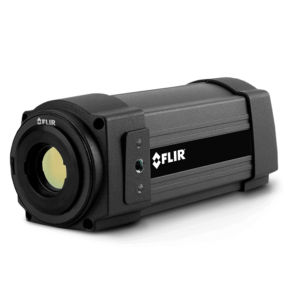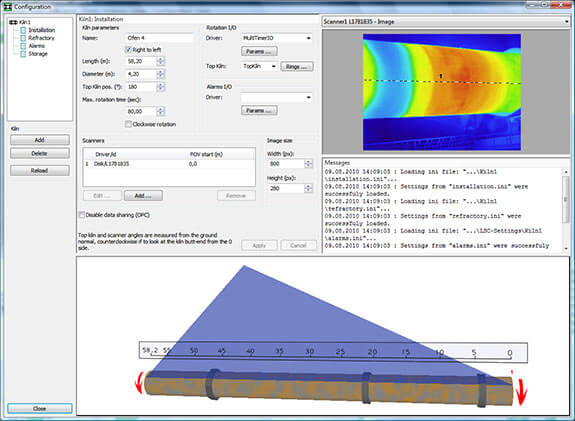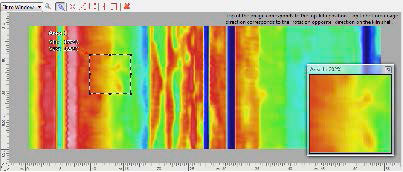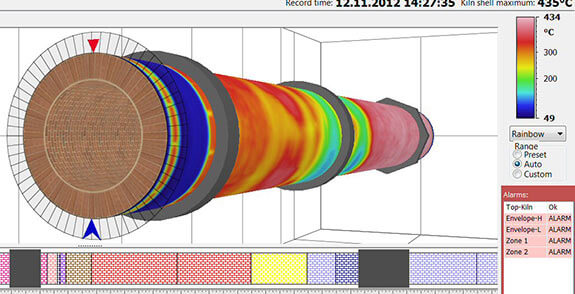
Today, it is impossible to imagine the building industry without cement. As an important component of masonry mortar and concrete, the manufacturing and use of cement products make cement one of the most valuable and useful mineral products in the world. Cement production is a complex process, in which one of the steps consists of blending limestone with other components in big rotary furnaces. These furnaces or kilns are a critical asset of a cement production plant, heating their contents to temperatures up to 1500 °C. There is, however, a risk of overheating, which can cause serious damage to the kiln shell. In order to monitor this delicate heating process and prevent possible damage to the kiln, thermal imaging cameras from FLIR Systems are used to measure temperatures on a 24/7 basis.
We have developed the KilnMonitor, an advanced computer system that allows cement production operators to monitor, process, and trace data from several kilns at once. Our company, Agile Microsys, is an official FLIR Systems distributor. The company has wide expertise in high-tech equipment for industrial safety applications.
The KilnMonitor system includes FLIR cameras, which monitor the kiln temperature in real-time. In addition, it includes, among other things, a kiln visualization module (2D and 3D) and a thermographic analysis module. We have designed the system to be integrated with the FLIR camera. These products provide exactly the detailed thermal data that is needed for this type of application.

Protecting the kiln shell
The shell is critical for the operational performance of the kiln. Thermal imaging cameras can at least detect two different problems regarding this shell.
Firstly, during operation, a ring of cement coating is piling up inside the shell on the refractory brick surface. On the one hand, this is beneficial, as it lowers the shell temperature, reducing heat losses, and protecting the refractory material. On the other hand, furnace operators need to be aware that this coating does not get too thick, as this will reduce the internal diameter and, as a result, reduce the furnace’s production performance. By detecting low temperatures on the kiln shell, thermal imaging cameras can make operators aware of this problem.
Secondly, unstable cement coating or sudden detachment of coating material easily leads to problems with the refractory material and can cause refractory bricks to fall off. As the protecting layer is then damaged and its thickness reduced, hot spots are formed inside the shell, which results in loss of energy and disturbed kiln operation. To protect the steel shell from damage, its temperature should remain below 350 °C. This can of course easily be monitored with thermal imaging cameras.
Kiln monitoring system
The Kiln Shell Temperature Monitoring Solution makes use of three A310 cameras, each scanning one-third of the 60 m long rotary kiln. These thermal video streams are distributed to a visualization system inside the central control room and provide operators with a 24/7 real-time view of the kiln operation and performance. The kiln has a rotation time of around 30 seconds and the IRT KilnMonitor® is synchronized to the rotation time to build up a thermal image.
Whenever the kiln shell reaches an undesired temperature, operators receive dedicated software alerts, which allow them to take the appropriate remedial actions. For example, hot spots in the thermal image of the furnace can indicate that refractory bricks have become detached from the refractory lining and that the protective kiln layer is becoming less thick. This may require the furnace operators to reduce the temperature of the burner or even shut the system down in order to prevent severe damage and avoid large costs.
Accurate thermal views
To give control room operators the best possible view of the situation, the Rotary Kiln Shell Temperature Monitoring System generates several different viewing modes based on the information received from the FLIR thermal imaging cameras.


Thermal imaging cameras versus scanners
The image quality is not the only advantage of the FLIR thermal imaging cameras. When comparing them with thermal imaging scanners, another commonly used technology for kiln shell temperature monitoring, it is clear that thermal imaging cameras offer the end customer a less expensive solution.
“When scanners are used, then theoretically one scanner unit can suffice to monitor an entire 60 m rotary kiln,” said Ricca. “However, when using a scanner, the unit needs to be placed at a certain distance and the rotary kiln should be fully visible. In practice, this is not always possible. Thermal scanners can be quite bulky and are not very flexible in terms of installation. In many cases, a rotary kiln is installed inside a dedicated production hall. Taking into account that a thermal imaging scanner has a maximum viewing angle of 120°, it is very often impossible to install a thermal scanner at sufficient distance from the rotary kiln and avoid obstacles that are blocking the view. For example, with many rotary kiln installations, there is a secondary air tube that directs hot air out of the rotary kiln to be used as an energy source. This secondary tube will often be an obstacle.”
“In contrast, thermal imaging cameras are much smaller, much lighter and much more flexible in terms of placement and installation,” Ricca continued. “In fact, they are the preferred solution for installations where space is limited. In our system design, we used a FLIR with 90° lens. In this case, you would need three thermal imaging cameras to cover the total pipe length of 60 m, which is still cheaper than one thermal imaging scanner.”
